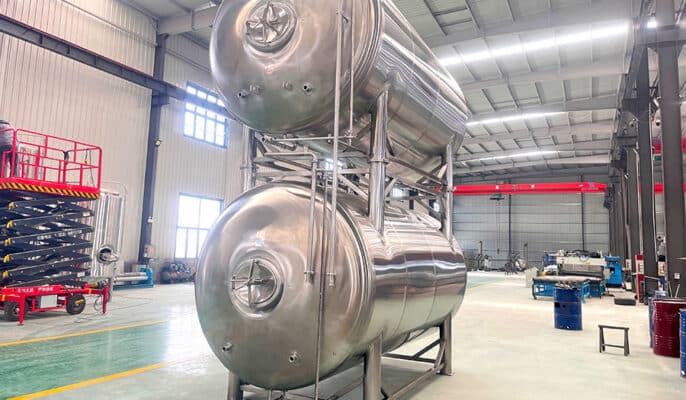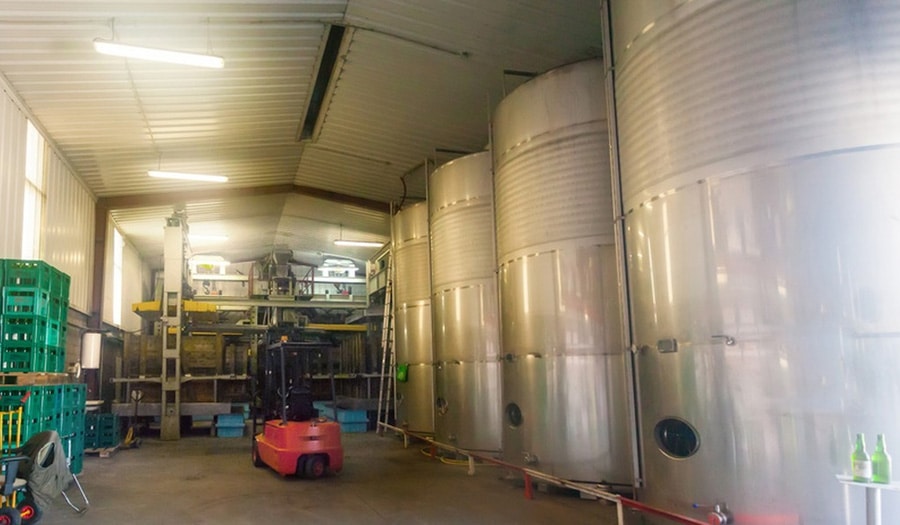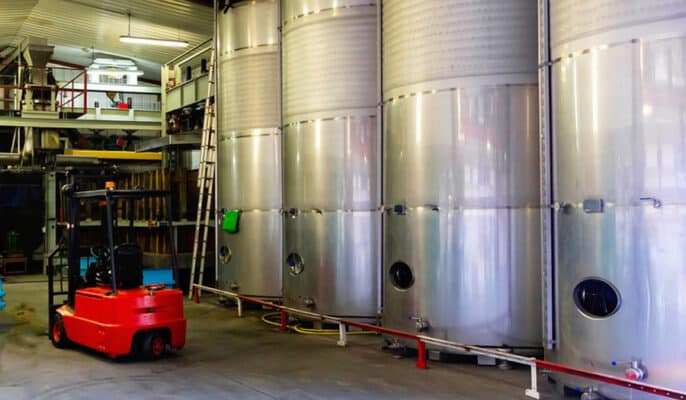In the brewing industry, turning raw ingredients into delicious beer is a complex combination of science and art. Bright tanks are an essential piece of equipment for this process. A bright tank is a special type used in the brewing industry. It is essentially a storage tank used to hold beer after it has fermented and before it is packaged for distribution. The term “Brite” refers to the fact that the beer in the tank is clear and bright, without any sediment or haze that may have been created during the fermentation process. These containers play a unique but equally important role in producing high-quality beer.
Che cos'è un Serbatoio Brite?
A Brite Tank is a stainless steel container used to carbonate and store beer. Brite tanks are also called service tanks, clear tanks, storage tanks, or secondary fermentation tanks. These tanks usually have pressure ratings and can be equipped with accessories that allow safe pressure transfer. The “Brite” in Brite tanks refers to the fact that these tanks are used to store beer that has already been fermented and clarified. Therefore, the beer in the storage tank is clear and can be drunk directly.
Features of Brite Tanks:
- Stainless steel material: durable and easy to clean, suitable for daily use, and can maintain the optimal temperature for beer storage.
- Shape: Brite tanks have various shapes, usually round or oval, which helps the wine release aroma evenly.
- Sealing: Good sealing is an important feature of sake tanks, which can prevent air from entering and reduce oxidation of the wine, thereby maintaining the taste and aroma of sake.
- Storage: Brite tanks are suitable for storing sake. Different types of sake have different requirements in temperature and storage conditions. The choice of sake tanks can affect the shelf life and taste of the wine.
- Drinking: Brite tanks are not only used for storage but can also be used for direct pouring. Using a dedicated sake container can add to the ritual and experience of drinking sake.
Come Carri armati luminosi Work?
Bright tanks are frequently used in commercial breweries because they offer several advantages over other types of beer storage containers. Bright tanks are pressurized and can be used to force-carbonate beer. Bright tanks are typically used at the end of the brewing process. Once the beer is finished fermenting, it is transferred from the fermentation tank to the bright tank. In some cases, the beer may be transferred to a conditioning tank before being transferred to the bright tank. The purpose of the conditioning tank is to allow the beer to mature and develop its flavor profile. After the transfer to the bright tank, it is cooled and carbonated. This is usually done using a carbonator, a device that is usually made of porous sintered stainless steel that diffuses carbon dioxide gas into the beer, promoting even, controlled carbonation.
Bright Tank Features and How They Work:
- Stainless Steel Construction: Most bright beer tanks are made of high-quality stainless steel that is durable, easy to clean, and will not react with beer or other liquids.
- Pressure Control: Beer tanks are pressurized to keep the beer carbonated and prevent it from going flat. The pressure can be adjusted to ensure a steady carbonation level.
- Temperature Control: Beer tanks are thermostatic, which is essential to maintaining the flavor and quality of the beer. Temperature control is critical during the fermentation and aging process.
- Pouring arm: The pouring arm is a special port that allows the brewer to pour beer from the tank while leaving behind any sediment or particles that may have settled on the bottom of the tank.
- Carbonate stone: The carbonate stone is a porous stone that fits over a port on the bottom of the beer tank. It releases tiny bubbles of carbon dioxide that dissolve into the beer to create the desired level of carbonation.
- Cleaning in place (CIP) system: Clear beer tanks are often equipped with an automated CIP system that cleans and sanitizes the tank after each use. This ensures the tank is ready for the next batch of beer and helps extend its life.
The process of beer brewing
- Mashing: This initial step involves soaking the crushed grains in hot water to extract the sugars and flavor substances that serve as the basis of beer.
- Filtration: The sweet wort (the liquid extracted from the grains) is separated from the leaves.
- Boiling: The wort is boiled with hops, which add bitterness and aroma, and act as a natural preservative.
- Fermentation: Yeast is added, which consumes the sugars in the wort and produces alcohol and carbon dioxide as byproducts. This is where the magic of beer brewing happens!
- Conditioning: After fermentation, the beer is transferred to the conditioning tank to settle and mature for some time. Here, the flavor of the beer can develop further and some residual yeast can solidify.
- Bright tank: The bright tank takes center stage. The conditioned beer is transferred to the bright tank for the final preparation stage, using a carbonator to add the exact amount of carbon dioxide to achieve the desired degree of fizziness. Depending on the desired clarity, filtration or natural sedimentation can be performed in the bright tank to remove any residual yeast or particles.
- Packaging and Distribution: The finished, clear beer is packaged into kegs, bottles, or cans for thirsty consumers to enjoy!

Why are bright tanks so important in brewing?
It is very important in sake brewing, and the main reasons include the following:
- Environmental control: Sake tanks can provide a relatively stable storage environment, control temperature, and humidity, and prevent the influence of the external environment on sake, thereby maintaining the flavor and quality of the wine.
- Oxygen isolation: Good sealing can prevent oxygen from entering, reduce the oxidation of sake, maintain the taste and aroma of the wine, and ensure the freshness of sake during storage.
- Avoid cross-contamination: Using dedicated sake tanks can prevent the wine from reacting with other odors or substances, ensure the purity of sake, and avoid cross-contamination.
- Promote the release of wine aroma: The shape design of the tank usually helps to release the aroma of the wine evenly, so that the unique flavor of sake can be better felt when drinking.
- Cultural symbol: Sake tanks are not only practical tools but also carry rich historical and craft values, which enhance the drinking experience and ritual sense of sake.
FAQ
Che cos'è un serbatoio luminoso?
A bright tank is a transparent or translucent storage tank that is often used in the brewing process to observe the color and state of the fermented liquid.
What is the main function of a bright tank?
It is mainly used for fermentation, clarification, and storage of liquids such as sake or beer. They can help brewers monitor the fermentation process and ensure quality.
How to use a bright tank?
The brewer pours the fermented liquid into the tank and adjusts the temperature and other conditions as needed to promote fermentation and clarification. After fermentation is completed, the liquid in the tank can be filtered and bottled.
What are the materials of bright tanks?
Common materials include stainless steel, glass, ceramic, etc.
What are the advantages compared to traditional serbatoi di fermentazione?
Bright tanks provide better visibility and monitoring capabilities, allowing brewers to help adjust the process in time at any time.
How to clean and maintain bright tanks?
After use, the tank should be thoroughly cleaned to remove residues. Appropriate detergents and warm water can be used to ensure that there are no residues and bacteria.





